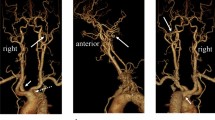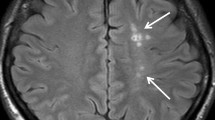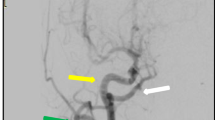Abstract
Purpose
We present a case of an aberrant right subclavian artery (ARSA) with extremely rare vascular anomalies.
Case report
A 69-year-old woman was suspected to have right internal carotid artery (ICA) stenosis. Computed tomography angiography demonstrated an ARSA and hypoplasia of the right ICA. The proximal segment of the right vertebral artery (VA) was aplasia, and a right type 1 proatlantal artery (PA) arose from the right common carotid artery. Cerebral angiography demonstrated segmental dysplasia of the right ICA. The ascending intrapetrous segment and the ascending foramen lacerum-horizontal intracavernous segment of the right ICA demonstrated hypoplasia. The collateral pathways promoted reconstitution of each of the distal segments. Left internal carotid angiography demonstrated anterior communicating artery aneurysm and sufficient cross flow to the contralateral middle cerebral artery via the AcomA.
Discussion
A type 1 PA with an ARSA may result in the regression of the right dorsal aorta with persistence of the first cervical intersegmental artery. Although there are few findings of a relationship between an ARSA and intracranial artery anomalies, a developmental error of the right dorsal aorta may cause such complex vascular anomalies.
Conclusion
Knowledge of anatomical variations in patients with ARSA is useful when performing angiography or endovascular therapy, as well as during clinical follow-up.



Similar content being viewed by others
References
Buffoli B, Verzeletti V, Hirtler L, Rezzani R, Rodella LF (2021) Retroeshophageal right subclavian artery associated with a bicarotid trunk and an ectopic origin of vertebral arteries. Surg Radiol Anat 43:1491–1495. https://doi.org/10.1007/s00276-021-02746-1
Chen C, Wang L, Wong Y (1998) Abnormal origin of the vertebral artery from the common carotid artery. Am J Neuroradiol 19:1414–1416
Gailloud P, Clatterbuck RE, Fasel JH, Tamargo RJ, Murphy KJ (2004) Segmental agenesis of the internal carotid artery distal to the posterior communicating artery leading to the definition of a new embryologic segment. Am J Neuroradiol 25:1189–1193
Garzon MC, Epstein LG, Heyer GL et al (2016) PHACE syndrome: consensus-derived diagnosis and care recommendations. J Pediatr 178:24-33.e2. https://doi.org/10.1016/j.jpeds.2016.07.054
Haughton VM, Rosenbaum AE (1974) The normal and anomalous aortic arch and brachiocephalic arteries. In: Newton TH, Potts DG (eds) Radiology of the skull and brain, vol 2. Book 2. Arteries. Mosby, St Louis, pp 1145–1163
Kumar S, Kumar P (2014) Truncus bicaroticus with aberrant right subclavian artery and origin of right vertebral from right common carotid artery. Surg Radiol Anat 36:829–831. https://doi.org/10.1007/s00276-013-1232-z
Lasjaunias P, Berenstein A (1987) Arterial Anomaly: Introduction. In: Lasjaunias P, Berenstein A (eds) Surgical neuroangiography, volume 1, Functional anatomy of craniofacial arteries, 1st edn. Springer-Verlag, Berlin, pp 1–32
Lasjaunias P, Santoyo-Vazquez A (1984) Segmental agenesis of the internal carotid artery: angiographic aspects with embryological discussion. Anat Clin 6:133–141. https://doi.org/10.1007/BF01773165
Lasjaunias P, Théron J, Moret J (1978) The occipital artery. Anatomy-normal arteriographic aspects-embryological significance. Neuroradiology 15:31–37. https://doi.org/10.1007/BF00327443
Lee JH, Oh CW, Lee SH, Han DH (2003) Aplasia of the internal carotid artery. Acta Neurochir 145:117–125. https://doi.org/10.1007/s00701-002-1046-y
Luh GY, Dean BL, Tomsick TA, Wallace RC (1999) The persistent fetal carotid-vertebrobasilar anastomoses. Am J Roentgenol 172:1427–1432
Newton TH, Mani RL (1974) The vertebral artery. In: Newton TH, Potts DG (eds) Radiology of the skull and brain, vol 2. Book 2. Arteries. Mosby, St Louis, pp 1659–1709
Ota T, Fujitani S, Fujimoto S, Saito H, Ueda M (2020) A rare anomalous origin of the right vertebral artery from the internal carotid artery with an aberrant right subclavian artery. World Neurosurg 139:250–252. https://doi.org/10.1016/j.wneu.2020.04.080
Saito N, Uchino A, Ishihara S (2013) Complex anomalies of type 1 proatlantal intersegmental artery and aortic arch variations. Surg Radiol Anat 35:177–180. https://doi.org/10.1007/s00276-012-1017-9
Tsai IC, Tzeng WS, Lee T et al (2007) Vertebral and carotid artery anomalies in patients with aberrant right subclavian arteries. Pediatr Radiol 37:1007–1012. https://doi.org/10.1007/s00247-007-0574-2
Uchino A, Tokushige K (2022) Type 2 left proatlantal artery with normal left vertebral artery and association with an aberrant right subclavian artery and a bi-carotid trunk. Surg Radiol Anat. https://doi.org/10.1007/s00276-022-02896-w
Funding
No funding.
Author information
Authors and Affiliations
Contributions
KI: project development, data collection and analysis, literature research and manuscript writing. HE: literature research, manuscript editing. KS: data analysis and literature research. RN: data collection and analysis. KO: data collection and management. HN: project development and total management.
Corresponding author
Ethics declarations
Conflict of interest
The authors declare that they have no conflict of interest.
Ethical approval
The ethics committee responsible (the Ethics Committee of Nakamura Memorial South Hospital) issued a waiver in written form for case reports.
Informed consent
Informed consent was obtained from this patient.
Additional information
Publisher's Note
Springer Nature remains neutral with regard to jurisdictional claims in published maps and institutional affiliations.
Rights and permissions
About this article
Cite this article
Ishikawa, K., Endo, H., Shindo, K. et al. Aberrant right subclavian artery with right type 1 proatlantal artery and segmental dysplasia of the right internal carotid artery: a case report. Surg Radiol Anat 44, 709–713 (2022). https://doi.org/10.1007/s00276-022-02950-7
Received:
Accepted:
Published:
Issue Date:
DOI: https://doi.org/10.1007/s00276-022-02950-7




